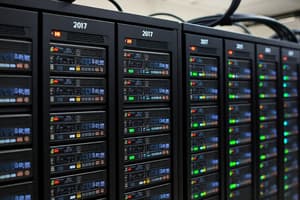Podcast
Questions and Answers
What is the primary function of a Domain Local Group in Active Directory?
What is the primary function of a Domain Local Group in Active Directory?
- It assigns permissions to shared network resources. (correct)
- It includes accounts and groups from any domain within the forest.
- It includes only the accounts from external domains.
- It contains user accounts from multiple forests.
In AGDLP, what is the first step for assigning permissions?
In AGDLP, what is the first step for assigning permissions?
- Add user accounts to a Global Group. (correct)
- Add user accounts to a Universal Group.
- Add the Domain Local Group to a Global Group.
- Assign permissions to the Domain Local Group.
Which of the following statements about Global Groups is true?
Which of the following statements about Global Groups is true?
- Global Groups can contain accounts and groups from any domain in the forest.
- Global Groups are used solely for email distribution.
- Global Groups can only exist in standalone modes.
- Global Groups include accounts and groups only from the same domain. (correct)
What role does group nesting play in permission management?
What role does group nesting play in permission management?
What is the purpose of a Universal Group in Active Directory?
What is the purpose of a Universal Group in Active Directory?
What does the Domain Functional Level (DFL) control?
What does the Domain Functional Level (DFL) control?
What is the primary purpose of the Schema in Active Directory (AD)?
What is the primary purpose of the Schema in Active Directory (AD)?
What is a characteristic of a Primary DNS Zone?
What is a characteristic of a Primary DNS Zone?
How does Microsoft Passport enhance authentication?
How does Microsoft Passport enhance authentication?
What does a Stub Zone do in DNS management?
What does a Stub Zone do in DNS management?
Which statement about Windows Internet Name Service (WINS) is accurate?
Which statement about Windows Internet Name Service (WINS) is accurate?
What role do lmhosts and hosts files play in network management?
What role do lmhosts and hosts files play in network management?
What is a key feature of the Forest Functional Level (FFL)?
What is a key feature of the Forest Functional Level (FFL)?
What protocol is used to access directory service data in Active Directory?
What protocol is used to access directory service data in Active Directory?
What role is primarily responsible for managing schema updates in Active Directory?
What role is primarily responsible for managing schema updates in Active Directory?
Which of the following best describes a 'Domain' in Active Directory?
Which of the following best describes a 'Domain' in Active Directory?
Which tool is used for managing users and computers within Active Directory?
Which tool is used for managing users and computers within Active Directory?
In the context of Active Directory, what is a 'Forest'?
In the context of Active Directory, what is a 'Forest'?
Which of the following correctly describes the relationship between domains in a tree?
Which of the following correctly describes the relationship between domains in a tree?
What distinguishes a Domain from a Workgroup?
What distinguishes a Domain from a Workgroup?
Which command-line interface tool is used for managing Active Directory services?
Which command-line interface tool is used for managing Active Directory services?
What is the primary purpose of Organizational Units (OUs) in Active Directory?
What is the primary purpose of Organizational Units (OUs) in Active Directory?
What is a key feature of default containers in a Domain Controller?
What is a key feature of default containers in a Domain Controller?
Which type of user profile reverts to a default state upon logoff?
Which type of user profile reverts to a default state upon logoff?
What is the format used to define a Universal Naming Convention (UNC)?
What is the format used to define a Universal Naming Convention (UNC)?
What do domain accounts rely on for access to services?
What do domain accounts rely on for access to services?
Which of the following statements about local accounts is true?
Which of the following statements about local accounts is true?
When assigning permissions to an OU, what must occur first?
When assigning permissions to an OU, what must occur first?
What characteristic distinguishes a Roaming User Profile?
What characteristic distinguishes a Roaming User Profile?
Study Notes
Active Directory Overview
- Active Directory (AD) is a hierarchical and secure database that stores information about network objects like users, computers, and services.
- Objects are identified by names and attributes.
- AD is organized into domains, trees, and forests.
- LDAP (Lightweight Directory Access Protocol) is used to access data within AD.
- Kerberos provides secure authentication between users and servers.
- DNS (Domain Name System) translates domain names into IP addresses.
Active Directory Management
- Active Directory Administrative Center (ADAC) is a graphical user interface (GUI) tool used to manage AD.
- Active Directory Users and Computers (ADUC) is a tool for managing user and computer accounts.
- Active Directory Domains and Trusts is used for managing domain and trust information.
- Active Directory Sites and Services manages replication between different sites.
- Active Directory Module for PowerShell uses cmdlets to manage AD.
Domain Controllers (DC)
- Domain Controllers authenticate users within a domain.
- All DCs are prioritized (e.g., DC1, DC2) and function similarly.
- These servers host the Active Directory Domain Services (AD DS) role.
Domain, Tree, and Forest
- A domain is a logical group of users, computers, and services managed by a DC.
- A tree comprises one or more domains linked through transitive trust relationships.
- A forest is a collection of tree domains with a root domain.
- Child domains are subdomains of a tree, inheriting the structure of the parent domain.
Operations Master Roles
- Five master roles exist in AD:
- Forest-wide roles:
- Schema Master: Manages the schema, which defines object types and attributes.
- Domain Naming Master: Manages the naming context for the forest.
- Tree domain-wide roles:
- RID Master: Manages security identifiers (SIDs) within a domain.
- PDC Emulator: Emulates the functionality of a PDC (Primary Domain Controller) for compatibility with older Windows clients.
- Infrastructure Master: Manages object updates and attribute changes across different domains.
- Forest-wide roles:
Domain vs. Workgroup
- Domain: A centralized network environment with a dedicated server managing resources.
- Workgroup: A peer-to-peer network without a dedicated server, devices share resources equally.
Trust Relationships
- DCs and computers in AD are linked via trust relationships established through Kerberos authentication.
Functional Levels
- Forest Functional Level (FFL): Determines which Windows Server versions can be used across the entire forest.
- Domain Functional Level (DFL): Controls server versions and features within a specific domain.
- Windows Server 2019 requires at least Windows Server 2008 for both DFL and FFL.
Namespace
- Domains and child domains share a contiguous namespace, for example, programming.dautti.local.
Sites
- Sites define the physical network topology, while domains represent the logical structure.
Replication
- Directory partitions are synchronized across all DCs in a forest through replication, ensuring data consistency.
Schema
- The AD schema defines objects, classes, and attributes.
- Schema changes are replicated across all DCs.
Microsoft Passport
- A password-free authentication system based on FIDO standards.
- Uses two-factor authentication for secure service access.
DNS (Domain Name System)
- A hierarchical system that organizes domain names and IP addresses.
- Zones and resource records manage name resolution.
Hosts and lmhosts Files
- Hosts files map IP addresses to hostnames (DNS resolution).
- lmhosts files map IP addresses to computer names (NetBIOS resolution), allowing network communication.
Hostnames
- A hostname uniquely identifies a device in a network.
- Also referred to as a domain name.
DNS Zones
- Primary Zone: Holds the main DNS database, containing all domain records.
- Secondary Zone: Acts as a backup for the primary zone, used when the primary is unavailable.
- Stub Zone: A secondary zone without an editable database, helping to find authoritative DNS servers.
- Authoritative DNS: Holds the authoritative DNS records for a domain, configured manually or dynamically.
- Non-Authoritative DNS: Contains cached DNS lookup information for quicker resolution.
Windows Internet Name Service (WINS)
- Automates NetBIOS name resolution by mapping IP addresses to NetBIOS names.
Universal Naming Convention (UNC)
- A standard format for identifying shared network resources, originally used in Unix.
- Example: \servername\folder.
Organizational Units (OUs)
- OUs help organize AD objects for easier management.
- They are default containers created when a server is promoted to a DC.
- These containers cannot be renamed, deleted, or associated with Group Policy Objects (GPOs).
Hidden Containers
- Hidden containers are not visible by default to maintain a cleaner interface and improve security.
Default Containers
- Default containers can be viewed by enabling Advanced Features in the AD console's View menu.
Studying That Suits You
Use AI to generate personalized quizzes and flashcards to suit your learning preferences.
Related Documents
Description
This quiz covers the fundamentals of Active Directory, including its structure, key protocols, and management tools. Understand the role of objects in AD, the use of LDAP and Kerberos, and the graphical interfaces available for administration. Test your knowledge on domain controllers and replication management.



